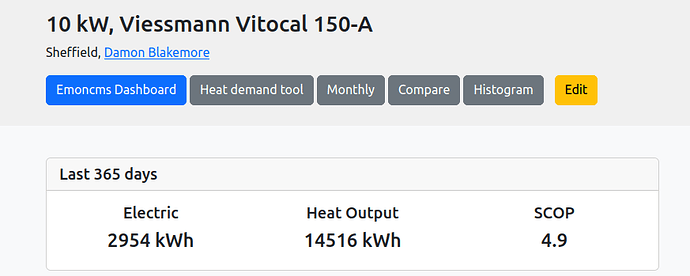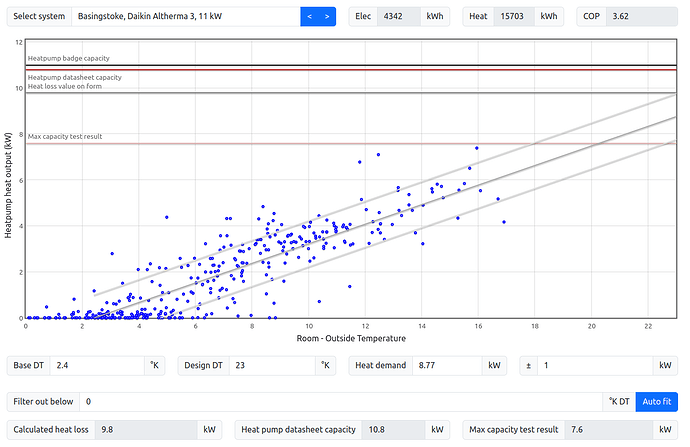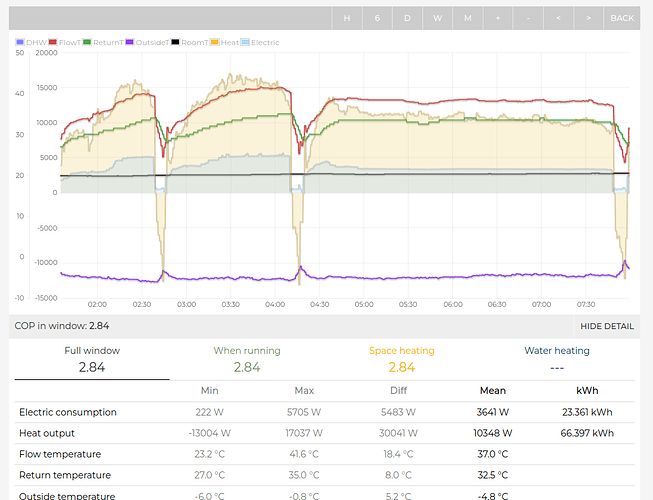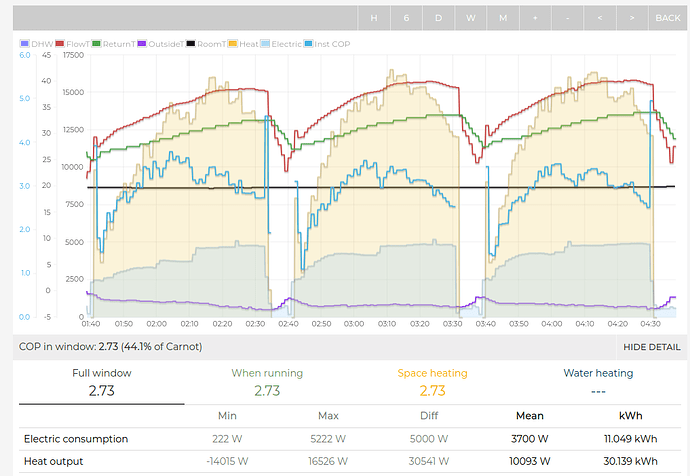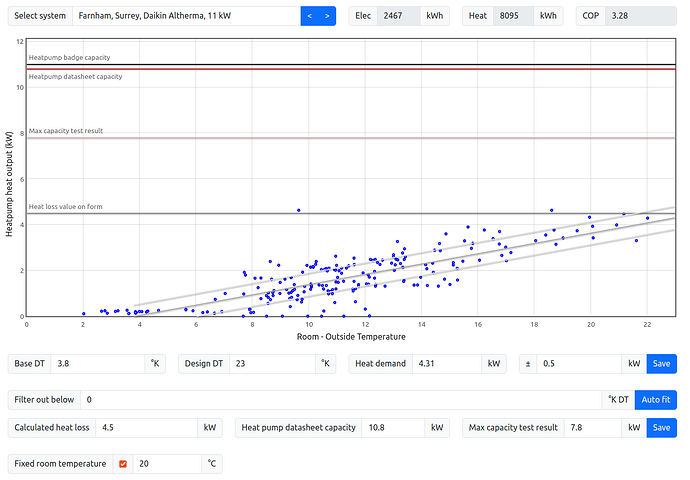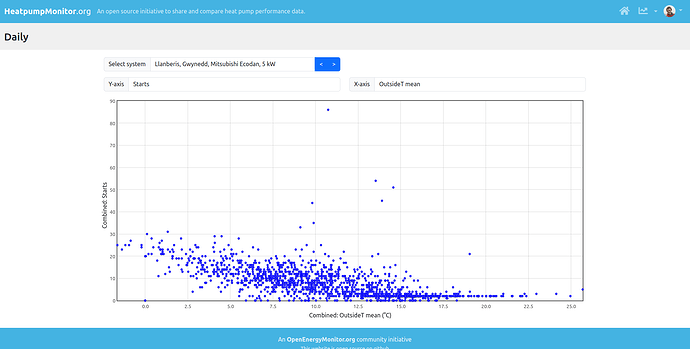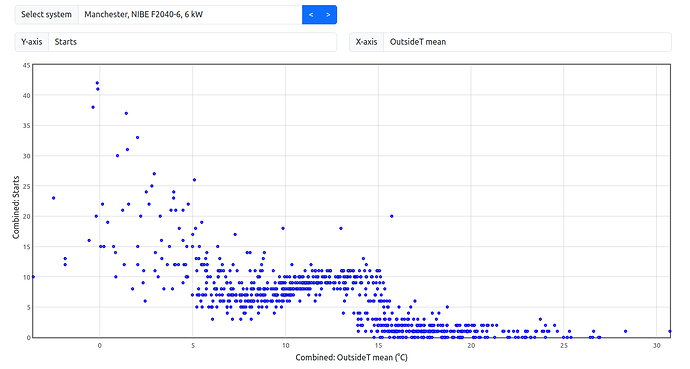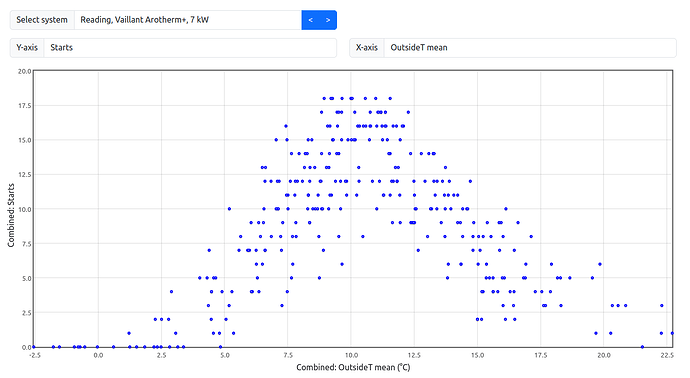‘Oversize’ may become more common as the heating requirement becomes a smaller portion of the demand, due to warmer weather and/or better building fabric. I sized our unit (5KW) on the time taken to (re)heat a tank of hot water (without an additional immersion heater) -that being the larger of the two demands. Based just on the heat requirements we could have gone a size down. The cycling, as we have come in to the shoulder months has noticeably impacted the efficiency, but it may also have had the same effect on the smaller unit (as both have the same minimum continuous power output). A small gain in the DHW efficiency may outweigh a slight loss in space heating efficiency…
I’ve added the links to the other tools and improved the performance on mobile of the new heat demand tool.
Looks really good Trystan.
I’ve tried this on my heat pump (Farnham, Surrey, Daikin Altherma, 11kw) which I know is very oversized. But I don’t get any data. Does it require me to add some extra details somewhere? I couldn’t work it out.
The heat loss tool requires room temperature data
Thanks Glyn. Obvious when you say it.
I don’t have internal temperature sensors logged in the system. Can I add a time-series in manually to make this work?
My house is always within 0.5C of 20.5C, so I could just put in a record of 20.5C or it would be handy to have an over-ride in the tool to be able to add a fixed room temperature? I get the purest view that it’s a bit of a bodge, but someone estimating their heat loss they would have a good idea whether temperature in their own property has been maintained 24/7.
Yes good idea, I will add this in.
Another minor update to the tool, it’s now possible to edit capacity figures that set the lines on the graph directly in the tool rather than having to switch between the form and the tool.
I’ve also added an option to provide a ‘max capacity test result’ which may be different from ‘datasheet capacity’. E.g @ColinS’s 11kW Daikin which we believe can’t reliably deliver more than 7.8 kW during heavy defrost conditions, having the option to include this line illustrates that the data sheet values are in question at least. (Link to data: ASHP sizing for Freezing Conditions - #63 by TrystanLea)
Ultimately I’d like to move test results like this to a heatpump make/model specific page, with a link to the period under which the test was performed so that those interested can double check the test.
The max capacity test result line should probably be called ‘Be careful designing for accurate heat loss above this line’.
Interestingly the East Midlands 11kW Daikin Altherma 3 gave 10.35 kW over ~6 hours at -4.8C outside here and it doesnt look maxed out… and the COP doesnt look low enough for a booster heater to be on?? interesting result @ColinS
https://emoncms.org/app/view?name=Altherma&readkey=dfb6fbf82b5eb4f396ba1e8acb146d66&mode=power&start=1705541700&end=1705564785&cool=1
Or 10 kW over 3 hours here at -2.5C https://emoncms.org/app/view?name=Altherma&readkey=dfb6fbf82b5eb4f396ba1e8acb146d66&mode=power&start=1705628330&end=1705639070&cop=1&carnot=0.441
Hi Trystan,
That 11kW Daikin is not an Altherma 3 Monobloc like Colin’s.
It is a hydro split system.
They can’t be compared to each other like that?
Aha, thanks @matt-drummer I didnt spot that in the notes, good to know!
I’ve added the fixed temperature option @HydroSam , here’s your system:
Recently featured on Hacker News - should drive a lot of interest ![]() One thing that came up was export of raw data in an agnostic format - is that possible?
One thing that came up was export of raw data in an agnostic format - is that possible?
(Just need to get a heat pump now…!).
This is really great and much easier to use than my hacky scripts ![]() .
.
One bug I observed: When I press auto fit, it automatically resets the x axis to 23 K DT even though I saved DT at 32 before. Then entering 32 K as DT again will shift the fit line so it’s no longer correct (or better the fit line stays where it was, the data shifts).
Hi Tristan
Thanks for the changes, looks good, and in line with what I have calculated outside the system.
Just need a proper cold spell in the data on here. I should try and see if I can get the 2.5 years of historic data out of the EoH project, I believe it’s in an open portal somewhere, but not an easily accessible format (to me at least), JSON I believe.
Doesn’t solve my problem of oversized heat pump, but at least I can’t be accused of manipulating the data in Excel ![]()
@TrystanLea thanks for the altherma split data. The flow temp is the same as mine but defrosts are far less frequent. I suspect the evaporator is better sized to get this result.
Happy to say that the costs page is now much improved with automated calculation of system unit cost of heat based on analysing each systems half hourly electricity data. It’s now possible to compare how each system performs on:
- Octopus Agile
- Octopus GO
- Octopus Cosy
- OVO Heat pump plus (flat tariff)
- Price cap (flat tariff)
As well as the user entered unit price that has been available for some time.
I’m using South Wales region for Octopus Agile, GO & Cosy price data as it seems to be middle of the range of all UK regions.
https://heatpumpmonitor.org/#mode=costs&tariff=agile
The automated unit price analysis uses heat pump electricity draw as used in the MyHeatpump app. This will be before any battery storage and home solar and so will not reflect actual grid import costs for all systems. I know quite a few people (myself included) use batteries to move electricity import into lower cost times and that at least from an import unit price perspective actual rates will be lower.
I think it’s useful to look at this from the heat pump demand in isolation of these additional systems as it should highlight systems that are shifting heat pump demand without secondary systems. Which is a topic a lot of people are interested in. It’s the goal of products like Homely and I know a number of people are turning off/down their heat pump during evening peak.
Batteries and solar also have their own cost of generation & storage. It would be interesting to hear any thoughts on numbers for this. E.g a quick back of the envelope calculation that I did when deciding when to charge and discharge my battery came out to ~11 p/kWh between the rate I should charge at and the rate that Im displacing by discharging later. (A 9.5 kWh battery costs about £5000 and has a lifespan of 7500 cycles of 8 kWh that’s a cost of 8.3p/kWh. Alternatively assuming a lifespan of 20 years and on average 5 kWh cycle every day = 13.7p/kWh).
At the same time if we start including installation costs of batteries and solar then perhaps heat pump installation cost should also factor in in an overall levelised cost of heat value…
I am interested in this sort of data. My heat pump will be installed by Octopus on the 22nd July. I just doubled my battery capacity to 19.2 kWh. I have my Shelly and M5 Tough ready to install and join the site with my stats.
I only have a 3.6 kWh inverter so in the winter it is likely to take all night to fully charge the batteries if they are flat.
I am used to my inverter picking the cheapest slots to charge. I will have to do this manually with the hot water picking the best slots to heat the water. I would hope Octopus would come up with a solution for this. In the winter Agile was cheaper enough overnight that I would stop the battery discharging and let it start around 7am.
I think running the heat pump is going to be more of a learning curve than the batteries.
Thanks @bazcurtis it will be interesting to hear how you get on!
There is now a new visualisation tool to explore the daily data on HeatpumpMonitor.org:
https://heatpumpmonitor.org/daily
The default view opens with Outside temperature vs Starts per day which gives some interesting patterns for different heat pumps:
The starting threshold used for these particular stats still needs more work to ensure the results are correct. This assumes that power draw drops below 100W when the compressor turns off and raises above this when it’s on to detect starts…
It would be great if we could separate out cooling, for example via supplying a binary label as for space heating and DHW. My current cooling runs distort the stats quite a bit.
